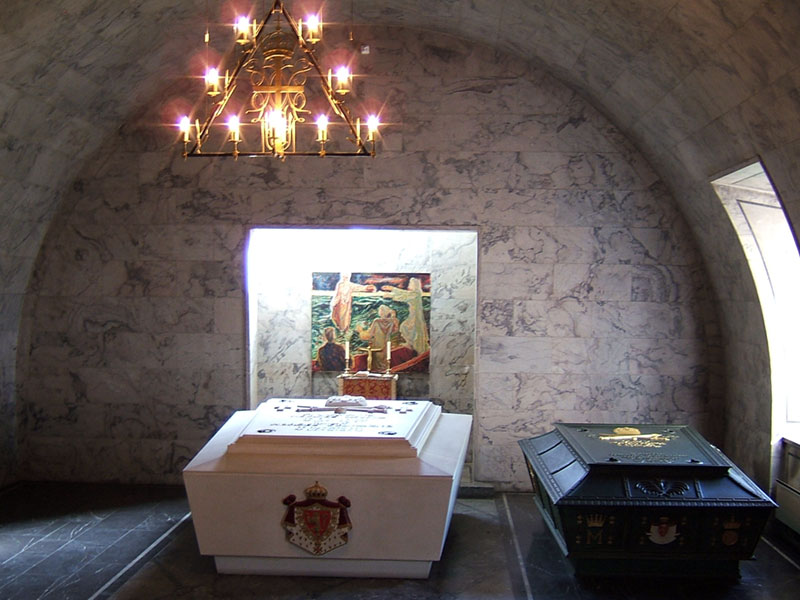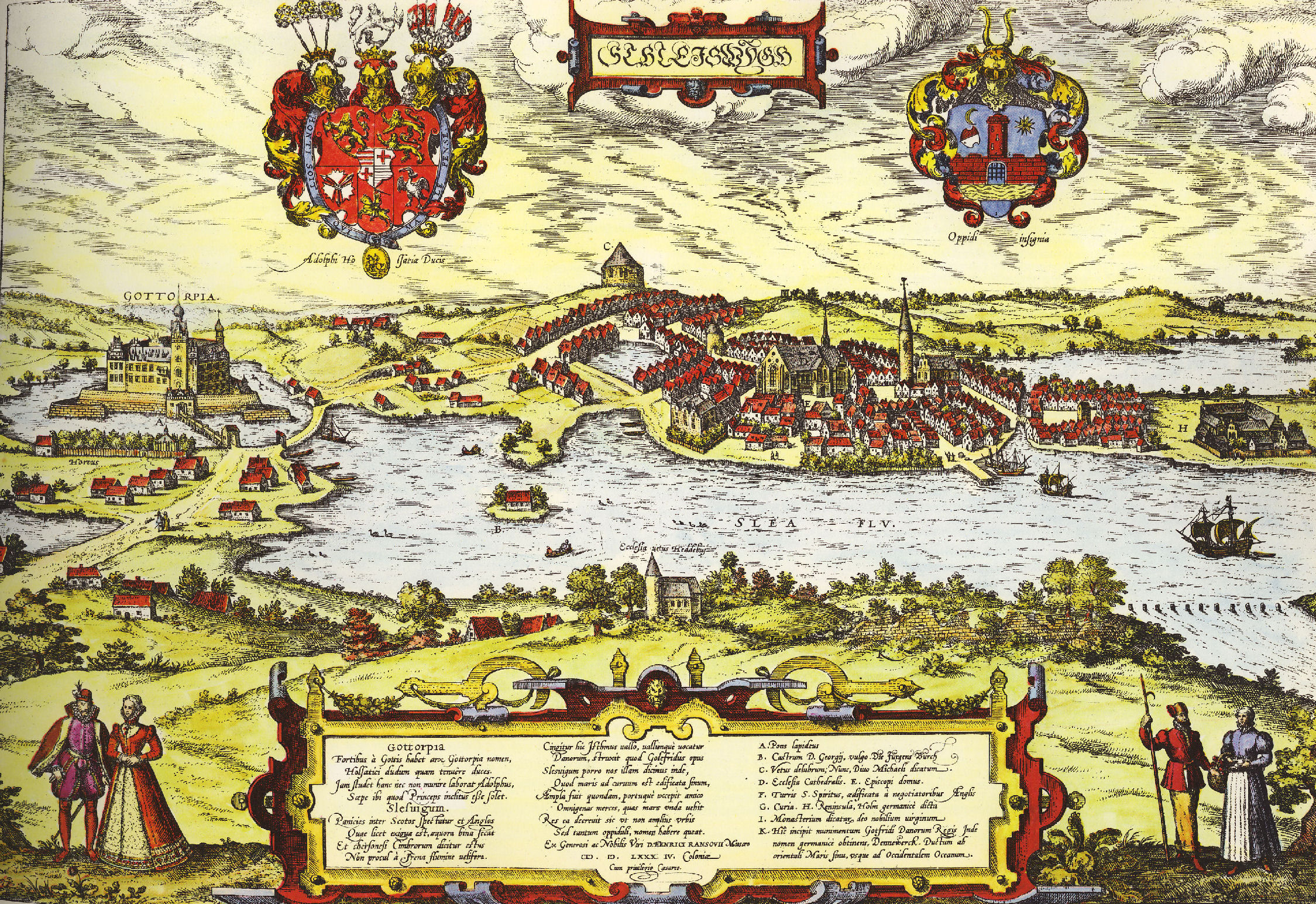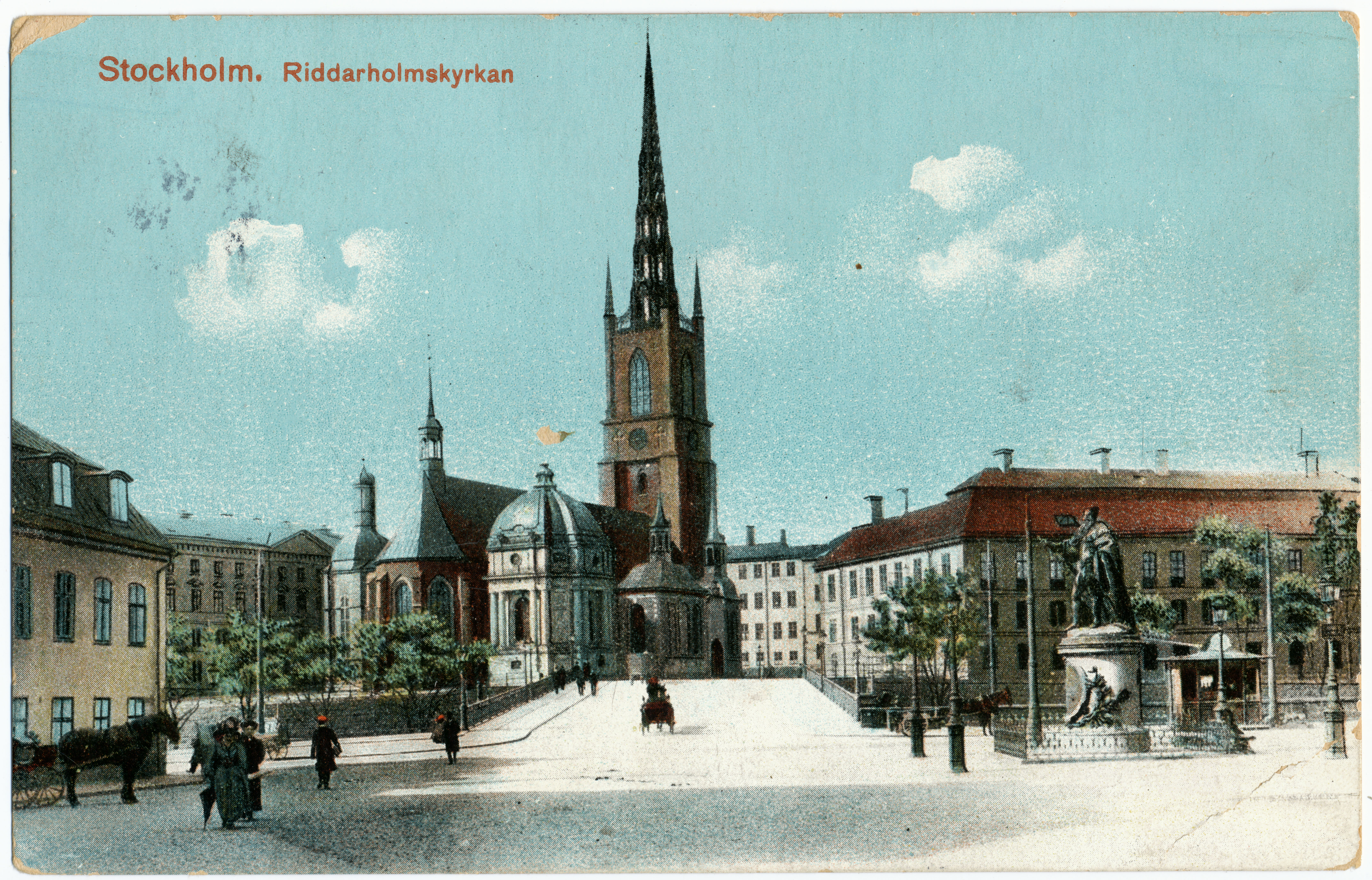|
Royal Mausoleum (Norway)
The Royal Mausoleum in Oslo, Norway, is located within the Akershus Castle, Castle of Akershus, where it was established in 1948. Information The Royal Mausoleum contains two sarcophagus, sarcophagi: in a white sarcophagus of marble rest King Haakon VII of Norway (1872–1957) and Queen Maud of Norway (1869–1938), née British princess, Princess Maud of Wales, and in a green sarcophagus rest King Olav V of Norway (1903–1991) and Crown Princess Märtha of Sweden, Märtha of Norway (1901–1954), née Kingdom of Sweden, Princess of Sweden. The Royal Mausoleum also contains, in its walls, the remains of King Haakon V of Norway (1270–1319) and Queen Euphemia of Rügen, Euphemia of Norway (1270–1312), née Prince of Rügen, von Rügen, as well as that of King Sigurd the Crusader, Sigurd I of Norway (c. 1090–1130). The remains were transferred from St Mary's Church, Oslo, St. Mary's Church and St. Hallvard's Cathedral, respectively, both in Oslo. Other burial sites Kings ... [...More Info...] [...Related Items...] OR: [Wikipedia] [Google] [Baidu] |
List Of Norwegian Monarchs
The list of Norwegian monarchs ( no, kongerekken or ''kongerekka'') begins in 872: the traditional dating of the Battle of Hafrsfjord, after which victorious King Harald Fairhair merged several petty kingdoms into that of his father. Named after the homonymous geographical region, Harald's realm was later to be known as the Kingdom of Norway. Traditionally established in 872 and existing continuously for over 1,100 years, the Kingdom of Norway is one of the original states of Europe: King Harald V, who has reigned since 1991, is the 64th monarch according to the official list. During interregna, Norway has been ruled by variously titled regents. Several royal dynasties have possessed the Throne of the Kingdom of Norway: the more prominent include the Fairhair dynasty (872–970), the House of Sverre (1184–1319), and the House of Oldenburg (1450–1481, 1483–1533, 1537–1814, and from 1905) including branches Holstein-Gottorp (1814–1818) and Schleswig-Holstein-Sonderburg ... [...More Info...] [...Related Items...] OR: [Wikipedia] [Google] [Baidu] |
Darłowo
Darłowo (Polish pronunciation: ; ; ), in full The Royal City of Darłowo ( pl, Królewskie Miasto Darłowo), is a seaside town in the West Pomeranian Region, at the south coast of the Baltic Sea, north-western Poland, with 13,324 inhabitants as of December 2021. It is located in Sławno County in West Pomeranian Voivodeship. The earliest archaeological signs of a settlement in the area occurred when Roman merchants travelled along the Amber Road in the hope of trading precious metals like bronze and silver for amber. By the 11th century the location of the later town was already becoming a significant trading point. The settlement received its town rights in 1312. Over the years Dukes of Pomerania constructed a Ducal Castle called Dirlow on a nearby island and chose it as their seat. It was here that the largest artillery piece in the world, Schwerer Gustav, was constructed and tested by Nazi Germany during World War II. The original medieval outline of Darłowo, based on th ... [...More Info...] [...Related Items...] OR: [Wikipedia] [Google] [Baidu] |
Germany
Germany,, officially the Federal Republic of Germany, is a country in Central Europe. It is the second most populous country in Europe after Russia, and the most populous member state of the European Union. Germany is situated between the Baltic and North seas to the north, and the Alps to the south; it covers an area of , with a population of almost 84 million within its 16 constituent states. Germany borders Denmark to the north, Poland and the Czech Republic to the east, Austria and Switzerland to the south, and France, Luxembourg, Belgium, and the Netherlands to the west. The nation's capital and most populous city is Berlin and its financial centre is Frankfurt; the largest urban area is the Ruhr. Various Germanic tribes have inhabited the northern parts of modern Germany since classical antiquity. A region named Germania was documented before AD 100. In 962, the Kingdom of Germany formed the bulk of the Holy Roman Empire. During the 16th ce ... [...More Info...] [...Related Items...] OR: [Wikipedia] [Google] [Baidu] |
Schleswig, Schleswig-Holstein
Schleswig (, , ; da, Slesvig; South Jutlandic: ''Sljasvig''; nds, Sleswig; archaic English: ''Sleswick'') is a town in the northeastern part of Schleswig-Holstein, Germany. It is the capital of the '' Kreis'' (district) Schleswig-Flensburg. It has a population of about 27,000, the main industries being leather and food processing. It takes its name from the Schlei, an inlet of the Baltic sea at the end of which it sits, and ''vik'' or ''vig'' which means "bay" in Old Norse and Danish. Schleswig or Slesvig therefore means "bay of the Schlei". History The Viking settlement of Hedeby, located south of the modern town, was first mentioned in 804. It was a powerful settlement in the Baltic region, dominating the area for more than 200 years. In 1050, following several destructions, the population was moved to the opposite shore of the Schlei, becoming the city of Schleswig. In 1066 Hedeby was finally destroyed, and Schleswig remained as a part of the Danish kingdom. In 1544, Gottor ... [...More Info...] [...Related Items...] OR: [Wikipedia] [Google] [Baidu] |
Schleswig Cathedral
Schleswig Cathedral (german: Schleswiger Dom, da, Slesvig Domkirke) officially the Cathedral of St. Peter at Schleswig (german: St. Petri-Dom zu Schleswig), is the main church of the city of Schleswig and was the cathedral of the Bishop of Schleswig until the diocese was dissolved in 1624. It is now a church of the North Elbian Evangelical Lutheran Church, the seat of the Lutheran Bishop of Schleswig and Holstein, and ranks among the most important architectural monuments of Schleswig-Holstein. History Predecessors In 850 a missionary church was founded in Haithabu (Hedeby). Between 947 and 949 Otto I installed three dioceses on the Cimbrian peninsula: Ribe, Schleswig and in 948 Århus. After the foundation of the Schleswig diocese in 947, the first cathedral in Schleswig was built. Today, neither the size nor the location of this cathedral is known. Construction In 1134, construction of a new romanesque basilica began. The work was only completed around 1200, because an ... [...More Info...] [...Related Items...] OR: [Wikipedia] [Google] [Baidu] |
Sweden
Sweden, formally the Kingdom of Sweden,The United Nations Group of Experts on Geographical Names states that the country's formal name is the Kingdom of SwedenUNGEGN World Geographical Names, Sweden./ref> is a Nordic country located on the Scandinavian Peninsula in Northern Europe. It borders Norway to the west and north, Finland to the east, and is connected to Denmark in the southwest by a bridgetunnel across the Öresund. At , Sweden is the largest Nordic country, the third-largest country in the European Union, and the fifth-largest country in Europe. The capital and largest city is Stockholm. Sweden has a total population of 10.5 million, and a low population density of , with around 87% of Swedes residing in urban areas in the central and southern half of the country. Sweden has a nature dominated by forests and a large amount of lakes, including some of the largest in Europe. Many long rivers run from the Scandes range through the landscape, primarily ... [...More Info...] [...Related Items...] OR: [Wikipedia] [Google] [Baidu] |
Stockholm
Stockholm () is the Capital city, capital and List of urban areas in Sweden by population, largest city of Sweden as well as the List of urban areas in the Nordic countries, largest urban area in Scandinavia. Approximately 980,000 people live in the Stockholm Municipality, municipality, with 1.6 million in the Stockholm urban area, urban area, and 2.4 million in the Metropolitan Stockholm, metropolitan area. The city stretches across fourteen islands where Mälaren, Lake Mälaren flows into the Baltic Sea. Outside the city to the east, and along the coast, is the island chain of the Stockholm archipelago. The area has been settled since the Stone Age, in the 6th millennium BC, and was founded as a city in 1252 by Swedish statesman Birger Jarl. It is also the county seat of Stockholm County. For several hundred years, Stockholm was the capital of Finland as well (), which then was a part of Sweden. The population of the municipality of Stockholm is expected to reach o ... [...More Info...] [...Related Items...] OR: [Wikipedia] [Google] [Baidu] |
Riddarholm Church
Riddarholmen Church ( sv, Riddarholmskyrkan) is the Church (building), church of the former medieval Greyfriars Monastery, Stockholm, Greyfriars Monastery in Stockholm, Sweden. The church serves as the final resting place of most Monarchs of Sweden, Swedish monarchs. Riddarholmen Church is located on the island of Riddarholmen, close to the Royal Palace in Stockholm, Sweden. The congregation was dissolved in 1807 and today the church is used only for burial and commemorative purposes. Swedish monarchs from Gustavus Adolphus of Sweden, Gustavus Adolphus (d. 1632 AD) to Gustaf V of Sweden, Gustaf V (d. 1950) are entombed here (with only one exception: Queen Christina of Sweden, Christina who is buried within St. Peter's Basilica in Rome), as well as the earlier monarchs Magnus III of Sweden, Magnus III (d. 1290) and Charles VIII of Sweden, Charles VIII (d. 1470). It has been discontinued as a royal burial site in favor of the Kungliga begravningsplatsen, Royal Cemetery and today i ... [...More Info...] [...Related Items...] OR: [Wikipedia] [Google] [Baidu] |
Denmark
) , song = ( en, "King Christian stood by the lofty mast") , song_type = National and royal anthem , image_map = EU-Denmark.svg , map_caption = , subdivision_type = Sovereign state , subdivision_name = Danish Realm, Kingdom of Denmark , established_title = History of Denmark#Middle ages, Consolidation , established_date = 8th century , established_title2 = Christianization , established_date2 = 965 , established_title3 = , established_date3 = 5 June 1849 , established_title4 = Faroese home rule , established_date4 = 24 March 1948 , established_title5 = European Economic Community, EEC 1973 enlargement of the European Communities, accession , established_date5 = 1 January 1973 , established_title6 = Greenlandic home rule , established_date6 = 1 May 1979 , official_languages = Danish language, Danish , languages_type = Regional languages , languages_sub = yes , languages = German language, GermanGerman is recognised as a protected minority language in t ... [...More Info...] [...Related Items...] OR: [Wikipedia] [Google] [Baidu] |
Copenhagen
Copenhagen ( or .; da, København ) is the capital and most populous city of Denmark, with a proper population of around 815.000 in the last quarter of 2022; and some 1.370,000 in the urban area; and the wider Copenhagen metropolitan area has 2,057,142 people. Copenhagen is on the islands of Zealand and Amager, separated from Malmö, Sweden, by the Øresund strait. The Øresund Bridge connects the two cities by rail and road. Originally a Viking fishing village established in the 10th century in the vicinity of what is now Gammel Strand, Copenhagen became the capital of Denmark in the early 15th century. Beginning in the 17th century, it consolidated its position as a regional centre of power with its institutions, defences, and armed forces. During the Renaissance the city served as the de facto capital of the Kalmar Union, being the seat of monarchy, governing the majority of the present day Nordic region in a personal union with Sweden and Norway ruled by the Danis ... [...More Info...] [...Related Items...] OR: [Wikipedia] [Google] [Baidu] |
Roskilde Cathedral
Roskilde Cathedral ( da, Roskilde Domkirke), in the city of Roskilde on the island of Zealand (Denmark), Zealand (''Sjælland'') in eastern Denmark, is a cathedral of the Lutheranism, Lutheran Church of Denmark. The cathedral is the most important church in Denmark, the official royal burial church of the Danish monarchs, and a UNESCO World Heritage Site. This is due to two criteria: the architecture of the cathedral shows 800 years of European architectural styles, and it is one of the earliest examples in Scandinavia of a Gothic architecture, Gothic cathedral to be built in brick; it encouraged the spread of the Brick Gothic style throughout Northern Europe. Constructed during the 12th and 13th centuries, the cathedral incorporates both Gothic and Romanesque architecture, Romanesque architectural features in its design. The cathedral has been the main burial site for List of Danish monarchs, Danish monarchs since the 15th century. As such, it has been significantly extended and a ... [...More Info...] [...Related Items...] OR: [Wikipedia] [Google] [Baidu] |




